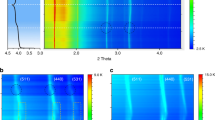Abstract
The capacity fade of spinel lithium manganese oxide in lithium-ion batteries is a bottleneck challenge for the large-scale application. The traditional opinion is that Mn(II) ions in the anode are reduced to the metallic manganese that helps for catalyzing electrolyte decomposition. This could poison and damage the solid electrolyte interface (SEI) film, leading to the the capacity fade in Li-ion batteries. We propose a new mechanism that Mn(II) deposites at the anode hinders and/or blocks the intercalation/de-intercalation of lithium ions,which leads to the capacity fade in Li-ion batteries. Based on the new mechanism assumption, a kind of new structure with core-shell characteristic is designed to inhabit manganese ion dissolution, thus improving electrochemical cycle performance of the cell. By the way, this mechanism hypothesis is also supported by the results of these experiments. The LiMn2-x Ti x O4 shell layer enhances cathode resistance to corrosion attack and effectively suppresses dissolution of Mn, then improves battery cycle performance with LiMn2O4 cathode, even at high rate and elevated temperature.
Similar content being viewed by others
References
Nicholas P W, Zhongyi Liu, Peng Lu, et al. Understanding Transition-metal Dissolution Behavior in LiNi0.5Mn1.5O4 High-voltage Spinel for Lithium Ion Batteries[J]. J. Phys. Chem. C, 2013, 117: 15947–15957
Jonghyun Park, Jeong Hun Seo, Gregory Plett, et al. Numerical Simulation of the Effect of the Dissolution of LiMn2O4 Particles on Li-ion Battery Performance[J]. Electrochemical and Solid-State Letters, 2011, 14(2): 14–18
Gummow R J, Dekock, A, Thackeray, M M. Improved Capacity Retention in Rechargeable 4 V Lithium/Lithium Manganese Oxide (Spinel) Cells[J]. Solid State Ionics, 1994, 69: 59–67
Amatucci, G G. Materials’ Effects on the Elevated and Room Temperature Performance of C/LiMn2O4 Li-ion Batteries[J]. J. Power Sources, 1997, 69: 11–25
Choa J, Thackeray M M. Structural Changes of LiMn2O4 Spinel Electrodes During Electrochemical Cycling[J]. J. Electrochem. Soc., 1999, 146: 3577–3581
Blyr A. Self-Discharge of LiMn2O4/C Li-ion Cells in Their Discharged State[J]. J. Electrochem. Soc., 1998, 145: 194–209
Amine K. Improved Lithium Manganese Oxide Spinel/Graphite Li-ion Cells for High-Power Applications[J]. J. Power Sources, 2004, 129: 14–19
Chun Zhan, Jun Lu, A Jeremy Kropf, et al. Mn(II) Deposition on Anodes and Its Effects on Capacity Fade in Spinel Lithium Manganate-Carbon Systems[J]. Nature Comm., 2013, (10): 1–8
Wang Zhenpo, Xie Guowei, Gao Lijun. Electrochemical Characterization of Li4Ti5O12/C Anode Material Prepared by Starch-sol-assisted Rheological Phase Method for Li-ion Battery[J]. Journal of Nanomaterials, 2012(5): 1–7
Hajime Tsunekawa, Satoshi Tanimoto, Ryoji Marubayashi, et al. Capacity Fading of Graphite Electrodes Due to the Deposition of Manganese Ions on Them in Li-ion Batteries[J]. Journal of the Electrochemical Society, 2002, 149(10): 1326–1331
Li Tan, Li Zhang, Qingna Sun, et al. Capacity Loss Induced by Lithium Deposition at Graphite Anode for LiFePO4/Graphite Cell Cycling at Different Temperatures[J]. Electrochimica Acta, 2013, 111: 802–808
Lu Chung-Hsin, Lin Shang-Wei. Dissolution Kinetics of Spinel Lithium Manganate and Its Relation to Capacity Fading in Lithium Ion Batteries[J]. J. Mater. Res., 2002, 17(6): 364–371
Zheng Honghe, Li Zhang, Gao Liu, et al. Correlationship Between Electrode Mechanics and Long-term Cycling Pperformance for Graphite Anode in Lithium[J]. J. Power Sources, 2012, 217: 530–537
Toshihiro Yoshida, Michio Takahashi, Satoshi Morikawa, et al. Degradation Mechanism and Life Prediction of Lithium-ion Batteries[J]. Journal of the Electrochemical Society, 2006, 153(3): 576–582
Yuki Yamada, Yasutoshi Iriyama, Takeshi Abe, et al. Kinetics of Lithium Ion Transfer at the Interface Between Graphite and Liquid Electrolytes: Effects of Solvent and Surface Film[J]. Langmuir, 2009, 25(21): 12766–12770
Author information
Authors and Affiliations
Corresponding author
Additional information
Funded by the National Natural Science Foundation of China (Nos. 21561016, 21661015), Jiangxi Provincial Science & Technology Program (Nos. 20133BBE50010, 20142BDH80020, and 20161BBE50052), and Science & Technology Program of Jiangxi Provincial Education Bureau (No. GJJ150775)
Rights and permissions
About this article
Cite this article
Chen, H., Ma, T., Zeng, Y. et al. Mechanism of capacity fading caused by Mn (II) deposition on anodes for spinel lithium manganese oxide cell. J. Wuhan Univ. Technol.-Mat. Sci. Edit. 32, 1–10 (2017). https://doi.org/10.1007/s11595-017-1547-4
Received:
Accepted:
Published:
Issue Date:
DOI: https://doi.org/10.1007/s11595-017-1547-4




